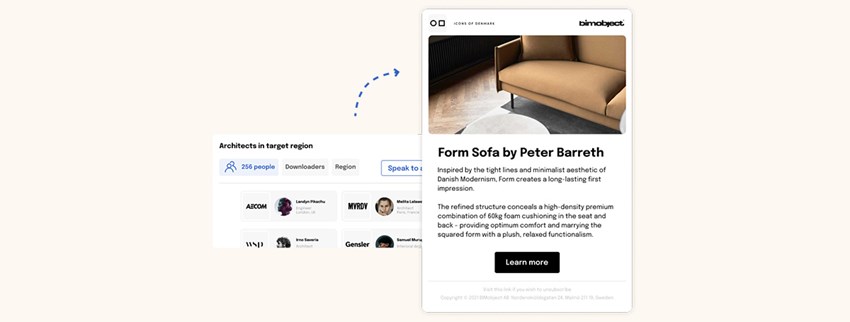2025 tradeshow highlights: BIMobject year-in-review
Discover key BIM trends from BIMobject’s 2025 event year insights from global tradeshows, digital workflows, sustainability talks, and manufacturer adoption.
Want to reach more architects, engage engineers, or influence interior designers efficiently? In that case, you need to go digital with your marketing efforts. Find out why digital marketing tools bring better awareness, results – and much more – in this 8-minute read.
This blog article is an extended excerpt from our e-book: Manufacturing the marketing mix. Get your copy now!

Surprised to see that acronym in the subheading? You might feel that it's an oversimplification. And in some ways – it is. But if you're new to manufacturing or feel that you need a quick specifier marketing rehash; it's an important comparison.
See, designers aren’t customers exploring products for personal consumption. They’re professionals who design buildings and suggest the purchasing of products to please private or public clients.
A specification process starts with the client’s concept brief. Then it's up to the architects and/or engineers to create a design and consider suitable products. When the perfect solution for the project is found, they’ll add it to the specification documentation.

At first glance, it might not seem all that complicated. But it is. The decision-making process involves tiers of project stakeholders, regulations, and perhaps even alignment with a green building certification system. And oh, let's not forget that every stakeholder has their own set of triggers and information needs.
As a manufacturer, this means you’re trying to reach a person who needs to align the decision-making process with other professionals and moving parts. The sales cycle is complex and long as it’s a high-value purchase with long-term performance goals.
Sounds awfully similar to the characteristics of B2B marketing and sales, right? That’s because it kinda is. The difference lies in the structure of business in construction where specification represents conversion and close (or intent to close*).

* Some countries prohibit brand-specific items in specifications for public projects. However, designers can create a workaround by detailing your unique item characteristics.
The building industry may be one of the oldest, with traditional methods being successful for many long-standing organizations. On-site installation training, interactive booths at trade shows, or being part of a building trade association are good ideas to get leads and can work. But relying on old-school messaging and traditional ways of doing things isn’t enough in today’s digital climate.

Let’s get something straight from the start: marketing isn’t a one-size fits all thing. A marketing strategy for a building product manufacturer (BPM) is likely to be different from most other industries. Although traditional tactics may work for your business, digital routes will need to be part of it too. Otherwise, you risk being left behind. Having an efficient and well-thought-out digital strategy in place is imperative for success today.
Digital natives are making up a larger part of the decision-making process. These individuals don’t view digital channels as a necessary evil. Quite the opposite. For Millennials (and other generations), digital tools are intrinsic to work and play.
Want proof in the context of construction? 59% of our users in architecture, engineering, and construction discover new products through digital mediums such as search engines or manufacturer websites. You can read the full breakdown of specifier research patterns here, but only 9% state that trade shows as the primary medium.
Professionals who conduct research online won't find you if you lack a digital presence. If you want greater awareness, you need to ensure that your brand and products can be found through a Google search, on social media platforms, or on digital marketplaces for the construction industry. Preferably all.
Before you can start selling anything to anyone, you need to fully understand whom you’re selling to. Now, you may think that you already know who these people are. But while personas help create a framework – they're also biased. If you truly want to tap into what specifiers want, you have to dig into audience data.

So, what is data in the context of digital marketing? Simply put: audience data is information about those who respond to your advertisements and engage with your brand on digital outlets. Every visit, click, scroll, like, download, or follow gives you a better understanding of who your audiences are and what they want.
Apart from creating a more factual outline of prospective customers, audience data can also help you create audience segments and craft relevant messaging based on known attributes and/or actions.
Do you experience a bolt in MQLs (Marketing Qualifies Leads) after an industry event? And do you notice that your pipeline fizzles down the next month? You’re not alone. Many manufacturers (and marketers from most industries) struggle with an inconsistent influx of MQLs.
Digital tools can't guarantee a steady flow 24/7 365. What they can do is expand your brand presence, extend communication channels and nurture leads through promotional activities such as Email campaigns, Promoted products, and automated nurturing programs.

Limiting interactions to traditional media increases the risk of misinformation. Now, this might sound like a blanket statement, but once it's printed or broadcasted – it's out.
No take-backs.
But why does this pose a problem? Well, it can sully your reputation and relationships with specifiers. Architects, engineers, and construction professionals need quick, timely access to information. And they need to trust it. Product descriptions and technical specifications tend to become obsolete or inaccurate within a year. And you don't want those floating around and perhaps even underselling your updated product solutions, right?
Digital media, on the other hand, can always be edited, updated or removed. For instance: You can remove type-os, add new information and replace your product documentation with just a few clicks. No (literal) paper trails and no need for your sales colleagues to spend time re-educating and re-selling specifiers on your updated products or features.
Physical interactions are key to building human-to-human connections. But if the last two years of hardship have tough us anything, it is that we shouldn't take it for granted. And in many ways: digital technology has proven to be our social savior.
Needless to say: digital technology makes it possible for people, companies, and colleagues to connect no matter where in the world they happen to be. This presents an opportunity for brands to expand their horizons without spending a single moment on the road or in the sky.

Traditional media allows you to preach your message to the masses, but they come up short of proving the results in a quantifiable way.
Sure, there are ways to improve measurability such as adding a QR code or a link to your website on your printed assets. This can enable you to spot a spike in traffic or conversions, but it can't disclose the number of impressions/interactions or the all-important conversion rate.
Cookies, UTM tags, and platform analytics: digital tools can track every interaction, provide valuable insights into your efforts and help you calculate a more precise ROI. Anders Johansen, European Channel Manager at Electrolux, made quite a compelling argument during our recent webinar on How manufacturers can navigate the new digital landscape:
Digital tools aren't just for reaching architects and engineers. They carry heaps of internal benefits, too. One of them is increased productivity.
The power of digital tools is multifaceted. They can help you crunch and analyze hard numbers. They enable you to move from one-to-one to one-to-many. And they can automate mundane manual tasks. The freeing up of time means that you – and your team – can spend more time taking action on things that help you reach your goals and targets.
The productivity argument bears weight on the other end of the table, too. Architects, engineers, and interior designers aren't foreign to the notion of embracing digital tools to improve the building process. One of the major catalysts for digital change is the wider adoption (and mandating) of BIM: Building Information Modelling.
Well, it’s all very well putting your products out there and hoping that specifiers will bite, but it’s not always that easy. In a 2021 study by AIA, 90% of architects said they wanted manufacturers to get involved in the specification process. Another 88% consider collaboration critical to their success. But how can manufacturers tap into it?
We've previously argued that BIM needs to be in every manufacturer's marketing plan. And that point still stands. Whether you’re looking to drive brand and product awareness, boost your visibility, build and nurture engagement and leads or reduce the time and cost to specification, BIM could be the most important tool in your toolbox.
Creating BIM content satisfies specifier needs on multiple levels. The information-rich 3D replicas of physical products make it easy for architects and engineers to access the data they need to add your products into designs. It's a gigantic step in the right direction. But if you want to turn the step into a leap; you need proper marketing tools to maximize brand visibility and BIM object downloads.
BIMobject's marketplace offers marketers in manufacturing the tools to do just that. Apart from publishing your BIM content to over 5 million registered users, you can also analyze brand interactions, identify trends and create audience segments to send relevant Email campaigns and/or Search ads to the audiences you want to target.

Want to refine your marketing strategy? Explore BIMobject solutions catered for marketers.
Discover key BIM trends from BIMobject’s 2025 event year insights from global tradeshows, digital workflows, sustainability talks, and manufacturer adoption.
See how architects and engineers find products and what information they trust. Use these insights to shape your 2026 marketing plan.
Learn how BIM influences product selection and what makes specifiers choose one brand over another. Insights from BIMobject’s expert interview.